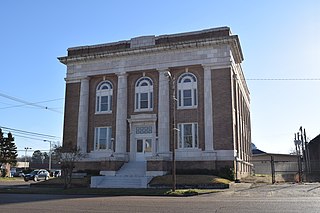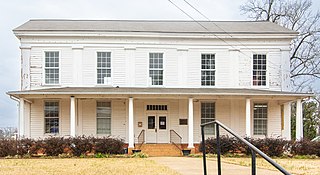
Lamar County is a county located in the U.S. state of Mississippi. As of the 2010 census, the population was 55,658. Its county seat is Purvis. Named for Confederate Lucius Quintus Cincinnatus Lamar, the county was carved out of Marion County to the west in 1904.
A Masonic Temple is the conceptual ritualistic space formed when a Masonic Lodge meets, and the physical rooms and structures in which it meets. It is also used in allegorical terms to describe a philosophical goal.
The Lamar County School District (LCSD) is a public school district based in Purvis, Mississippi (USA).

The McCain Library and Archives is the chief reserve library for The University of Southern Mississippi. It houses the items in Southern Mississippi's possession that are not available for checkout. Besides being the archives, the building also houses the office of the President Emeritus, and the universities audio visual department. The Archives also house the de Grummond Children's Literature Collection, one of the largest collections of children's literature in the world.

The Masonic Temple in Grenada, Mississippi is a Classical Revival building from 1925. It was listed on the National Register of Historic Places in 1988.
The Old Masonic Hall in Booneville, Mississippi, is a historic building that was designated a Mississippi Landmark in 1999. There is also a Old Masonic Hall in Louisville, Mississippi, also known as Community House, and as Chamber of Commerce, is a historic building built in 1851.

The Old Masonic Hall in Louisville, Mississippi, also known as Community House, and as Chamber of Commerce, is a historic building built in 1851. It was listed on the National Register of Historic Places in 1994 and was designated a Mississippi Landmark in 2007. It is a notable example of Greek Revival style architecture.
The Old Masonic Hall in Carrollton, Mississippi, also known as Carrollton Lodge No. 36, is a historic building built in 1899 that was designated a Mississippi Landmark in 2002.
The Masonic Hall in Gulfport, Mississippi, is a historic building that was designated a Mississippi Landmark in 2008.
The Old Masonic Hall in Hazlehurst, Mississippi, also known as Golden Square Lodge No. 88, Prince Hall Affiliation, is a historic building that was designated a Mississippi Landmark in 2002.
The Masonic Temple in Lexington, Mississippi, is a historic building that was designated a Mississippi Landmark in 2003.

The Masonic Hall in Long Beach, Mississippi, also the former home of Southern Star Lodge No. 500, F&AM and the Hancock County Bank Building, is a historic building that was designated a Mississippi Landmark in 2008.
The Pelahatchie City Hall and Masonic Hall in Pelahatchie, Mississippi is a historic building that was designated a Mississippi Landmark in 2007.
The Old Municipal Building and Masonic Hall in Shelby, Mississippi is a historic building built in 1935 that was designated a Mississippi Landmark in 2000.

Old Hattiesburg High School, located at 846 North Main Street, in Hattiesburg, Mississippi, was utilized as a public school building from around 1911 to 1959. The building was designated a Mississippi Landmark in 1986 and was added to the National Register of Historic Places in 1987. In 2007, the structure was heavily damaged by arson. Following extensive renovations, the building was converted into an apartment complex by 2021.

The Wiggins Depot was constructed in Wiggins, Mississippi in 1910 by the Gulf and Ship Island Railroad (G&SIRR) to serve as a replacement for the company’s original depot that was destroyed by fire in January of the same year. In the later half of the 20th century, the depot was being used only for storage and had fallen into disrepair. In 1999, the depot was acquired by the City of Wiggins and was designated a Mississippi Landmark. During the first decade of the 21st century, the depot was relocated within the city and was renovated for use as office space.
Robert Emmett Lee (1870–1925) was a prolific architect in Hattiesburg, Mississippi.







